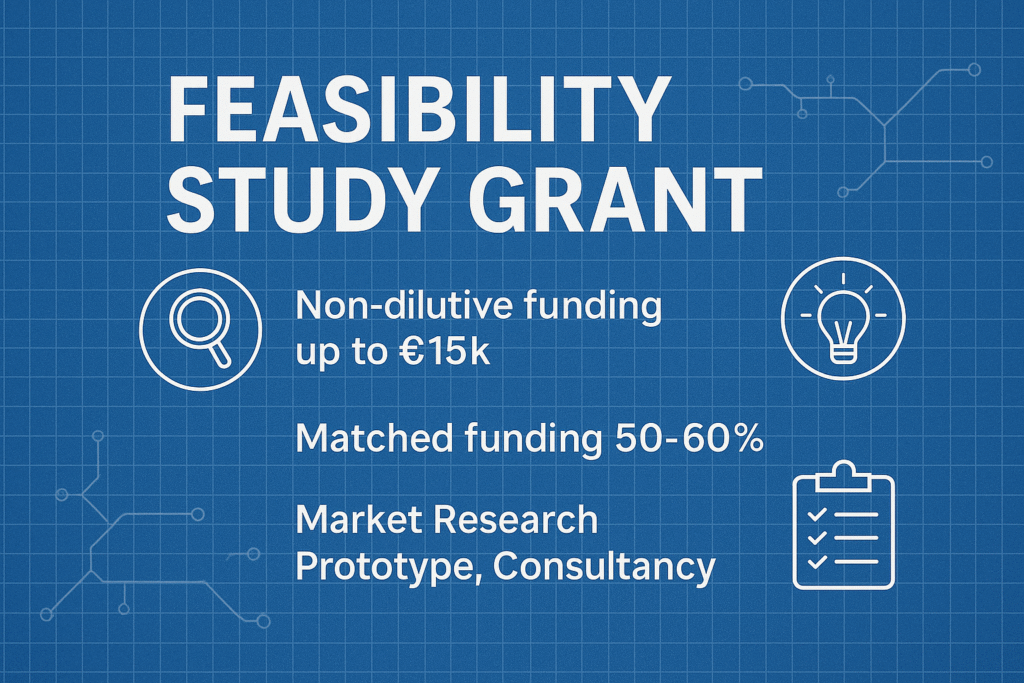LEO Feasibility Study Grant : Ireland’s Local Enterprise Office support for concept validation in manufacturing & internationally traded services.
Executive Summary
The Leo Feasibility Study Grant (FSG) is Ireland’s primary public instrument for entrepreneurs who need to test the technical and commercial viability of a brand-new product or internationally traded service before raising seed capital. Administered on a rolling basis by the Local Enterprise Offices (LEOs), the grant reimburses 50 % of eligible costs (60 % in the Border, Midlands & West region) up to €15,000. Funding can cover market research, prototype development, specialist consultancy, and the promoter’s own research time. Because the grant is non-dilutive and paid post-expenditure, it offers micro-enterprises (≤ 10 employees) a low-risk way to generate the data required for later investment or Enterprise Ireland support.
1. Programme Snapshot
| Item | Detail |
|---|---|
| Instrument | Non-repayable, matched-funding grant |
| Administered by | 31 Local Enterprise Offices (LEO) nationwide |
| Purpose | Validate the technical and market feasibility of a novel product/service prior to launch |
| Aid Intensity | 50 % of eligible costs (60 % in BMW region) |
| Grant Ceiling | €15,000 |
| Application Cycle | Rolling – apply any time; decisions typically 4–8 weeks |
2. Who Can Apply?
Core eligibility
-
Promoter stage: Individual founder or micro-enterprise exploring a new manufacturing or internationally traded service concept.
-
Headcount: ≤ 10 employees (linked-company rule applies).
-
Location: Business must be registered and operating within the LEO’s county jurisdiction.
-
Sector: Manufacturing or internationally traded services with export potential.
-
Ineligible sectors: Retail, local personal/professional services, construction, coal/steel, gambling, adult entertainment, tobacco, non-medicinal cannabis.
Linked-company rule – watch the hidden headcount
Include staff and financials from any partner (25–50 % holding) or linked (> 50 % holding) entities when assessing the 10-employee threshold. This prevents large groups from accessing micro-enterprise aid.
3. Eligible Cost Categories
| Category | Typical Examples | Advisory Note |
|---|---|---|
| Market Research | Consumer surveys, focus groups, export market sizing | Show why the data cannot be sourced from desk research alone. |
| Consultancy | Food technologist, UX specialist, IP attorney | Obtain written quotes; LEO may require CVs. |
| Technical Development / Prototype | Materials, lab tests, small-batch runs, 3-D printing | Capital equipment purchases are not eligible. |
| Salary / Own-Labour Research | Promoter time at LEO-capped hourly rate | Keep a signed timesheet log. |
| Miscellaneous | Travel to test sites, modest sample shipping | Must be clearly linked to feasibility tasks. |
All costs must be incurred after written grant approval; no retrospective claims.
4. Funding Mechanics & Cash-Flow Planning
-
Matched funding – LEO reimburses 50 % (60 % BMW) of approved spend.
-
Reimbursement model – Promoter pays first, then submits invoices, proofs of payment, and an activity report for draw-down.
-
Payment timing – Typical reimbursement within 30–45 days of final claim approval; build this lag into your cash-flow.
-
Grant expiry – Funds must usually be claimed within 6–9 months of the Letter of Offer; extensions are possible but not guaranteed.
5. Approval Criteria & Evaluation Lens
| Criterion | What LEO Looks For | Weight* |
|---|---|---|
| Innovation & Export Potential | Novelty, IP position, addressable export market | 35 % |
| Promoter Capability | Founder track record, relevant technical or sector skills | 25 % |
| Feasibility Plan Quality | Clear objectives, work-packages, and deliverables | 20 % |
| Commercial Viability Path | Credible route to sales, job creation potential | 15 % |
| Local Economic Fit | Alignment with county priorities, absence of displacement | 5 % |
*Indicative; each LEO sets its own weighting.
Common red flags
-
Project would proceed without state aid (deadweight).
-
Costs front-loaded into capital equipment or routine operating expenses.
-
Vague deliverables (“do marketing”) instead of testable milestones.
6. Playbook for a Winning Application
-
Frame a clear hypothesis – e.g., “Can we formulate a shelf-stable, low-sugar functional beverage for EU export at < €0.80 per 250 ml?”
-
Map tasks to questions – Link each cost line to the hypothesis (lab trials → chemical stability, consumer panels → flavour acceptance).
-
Quote rigorously – Attach supplier and consultant quotations; LEO evaluators dislike rule-of-thumb estimates.
-
Show skin in the game – Detail promoter cash contribution and hours; highlight any third-party collaboration (university, Teagasc, IMR, etc.).
-
Draft a post-study roadmap – Specify next steps (Priming Grant, NDRC accelerator, EI Pre-Seed), target customers, and projected job creation.
7. Strategic Value for Boards & Investors
-
Capital efficiency – Up to €15 k in free cash to de-risk technology before raising equity.
-
Dilution avoidance – Non-recoupable, non-equity funding preserves founder cap table.
-
Signal quality – LEO backing validates promoter diligence and market potential, a plus for pre-seed investors.
-
Gateway to further support – Positive feasibility outcomes strengthen cases for larger Priming or Business Expansion Grants, or Enterprise Ireland CSF/HPSU.
8. Professional Advisory Perspective
From an investor-readiness standpoint, the Feasibility Study Grant is an ideal “fail fast or go big” instrument. It compels founders to gather hard data—technical test results, real customer feedback, costings—before pursuing larger funding rounds. However, founders often underestimate administrative overhead: quotes, timesheets, and proof-of-payment trails can be time-consuming. Build at least 10 % of the project timeline for paperwork.
Boards backing spin-outs or management-buy-outs should ensure the feasibility scope is tightly defined (three to five deliverables) and that consultant outputs are contractually assigned to the company to avoid future IP leakage.
Disclaimer
All figures and conditions reflect LEO guidelines in force at the time of writing. Grant rates, caps, and eligible-cost definitions can change; always confirm with your Local Enterprise Office before incurring expenditure.




